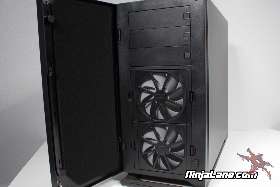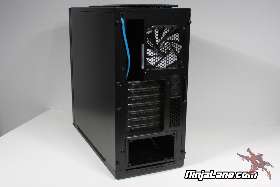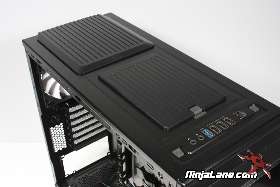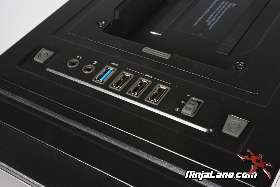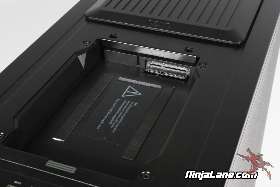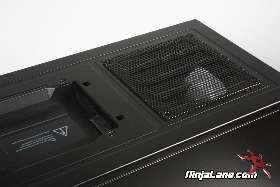NZXT H2 Silent Case Review
Author: Darren McCain
Published: Monday, July 11, 2011
Case Layout and Features
The front of the H2 is all door. Opening to the left the door is lined in noise dampening foam and closes firmly with magnetic enclosures. The top right corner acts as a pass through for the drive activity light. Venting for the two front 120mm fans is provided at the side and bottom through small vents around the door. The door doesn't open wide and isn't friendly to right side locations.
The back of the case shows the rear exhaust 120mm fan and features a pass through for the USB 3.0 run from the top ports. The choice to go with white fan blades adds some contrast to the attractive all black finish both inside and out. The H2 also has two 1/2 inch built in water-cooling pass through for an external reservoir.
Two removable covers on the top conceal an external drive bay and the top fan mountings. The top covers are a nice touch but the textured surface is not as clean a match for the smooth flat black that covers the rest of the case. A smooth finish would have allowed the covers to blend in when in place.
Two removable covers on the top conceal an external drive bay and the top fan mountings. The top covers are a nice touch but the textured surface is not as clean a match for the smooth flat black that covers the rest of the case. A smooth finish would have allowed the covers to blend in when in place.
The control panel is located in the top front and features the usual audio I/O ports, power and reset buttons, three USB 2.0 ports and one USB 3.0 port. A three speed fan control is also present for the front fans allowing you to run 40%, 70% or 100% on all three stock fans.
One of the more unique features of the H2 is the SATA hot swap bay shown here. The front cover is held in place by solid plastic latch and the bay is lined by two rubber pads to prevent damage and reduce noise. The bay will hold both 3.5" and 2.5" drives though the smaller drive may be a bit loose in the bay. The smaller drives would benefit from some sort of spacer or additional rubber strips to help keep things in place. I am not sure how often I would use this feature but it's definitely something I haven't seen in a case in this price range.
One of the more unique features of the H2 is the SATA hot swap bay shown here. The front cover is held in place by solid plastic latch and the bay is lined by two rubber pads to prevent damage and reduce noise. The bay will hold both 3.5" and 2.5" drives though the smaller drive may be a bit loose in the bay. The smaller drives would benefit from some sort of spacer or additional rubber strips to help keep things in place. I am not sure how often I would use this feature but it's definitely something I haven't seen in a case in this price range.
The back cover is solidly held in place by four magnets and can be easily removed. Even without the optional 120mm fan the cover can and probably should be removed for any higher load activities such as gaming or benchmarking.

